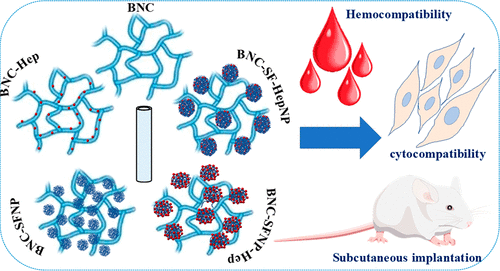当前位置:
X-MOL 学术
›
Biomacromolecules
›
论文详情
Our official English website, www.x-mol.net, welcomes your
feedback! (Note: you will need to create a separate account there.)
Improved Performance of Bacterial Nanocellulose Conduits by the Introduction of Silk Fibroin Nanoparticles and Heparin for Small-Caliber Vascular Graft Applications
Biomacromolecules ( IF 5.5 ) Pub Date : 2020-12-08 , DOI: 10.1021/acs.biomac.0c01211 Luhan Bao 1, 2, 3 , Feng F Hong 1, 2, 3 , Geli Li 2, 3 , Gaoquan Hu 2, 3 , Lin Chen 2, 3
Biomacromolecules ( IF 5.5 ) Pub Date : 2020-12-08 , DOI: 10.1021/acs.biomac.0c01211 Luhan Bao 1, 2, 3 , Feng F Hong 1, 2, 3 , Geli Li 2, 3 , Gaoquan Hu 2, 3 , Lin Chen 2, 3
Affiliation

|
Bacterial nanocellulose (BNC) is a promising material for small-caliber artificial blood vessels, although promoting its anticoagulant properties with more rapid endothelialization would improve long-term patency. Silk fibroin nanoparticles (SFNP) were introduced into the luminal wall surface of BNC conduits both with and without heparin (Hep) through pressurization followed by fixation. Hep was introduced in two ways: (1) embedded within SF nanoparticles to form SF-HepNPs for construction of the BNC-SF-HepNP conduit and (2) chemically grafted onto BNC and BNC-SFNP to form BNC-Hep and BNC-SFNP-Hep conduits. Fourier transform infrared spectroscopy confirmed the formation of SF-HepNPs, although they did not incorporate into the fibrillar network due to their large size. Hep was successfully grafted onto BNC and BNC-SFNP, verified by toluidine blue staining. The hemocompatibility and cytocompatibility of the five samples (BNC, BNC-SFNP, BNC-SF-HepNP, BNC-Hep, and BNC-SFNP-Hep conduits) were compared in vitro. The heparinized BNC-Hep and BNC-SFNP-Hep conduits improved the anticoagulant properties, and BNC-SFNP-Hep promoted human umbilical vein endothelial cell proliferation but also controlled excessive human arterial smooth muscle cell proliferation, assisting rapid endothelialization and improving lumen patency. No significant inflammatory reaction or material degradation was observed after subcutaneous implantation for 4 weeks. Autogenous tissues were observed around the conduits, and cells infiltrated into the edges of all samples, the BNC-SFNP conduit causing the deepest infiltration, providing an appropriate microenvironment for angiogenesis when used in small-caliber blood vessel applications. Few inflammatory cells were found around the BNC-Hep and BNC-SFNP-Hep conduits. Thus, the anticoagulant properties of the BNC-SFNP-Hep conduit and its stimulation of endothelialization suggest that it has great potential in clinical applications as a small-caliber artificial blood vessel.
中文翻译:

通过引入丝素蛋白纳米颗粒和肝素用于小口径血管移植应用,改善细菌纳米纤维素导管的性能
细菌纳米纤维素(BNC)是用于小口径人造血管的有前途的材料,尽管通过更快速的内皮化促进其抗凝特性将改善长期通畅性。通过加压和固定,将丝素蛋白纳米颗粒(SFNP)引入有或没有肝素(Hep)的BNC导管腔壁表面。引入Hep的方式有两种:(1)嵌入SF纳米粒子中以形成SF-HepNPs,以构建BNC-SF-HepNP导管;(2)化学接枝到BNC和BNC-SFNP上以形成BNC-Hep和BNC-SFNP -管道。傅立叶变换红外光谱证实了SF-HepNPs的形成,尽管由于它们的大尺寸而没有并入原纤维网络。Hep已成功嫁接到BNC和BNC-SFNP上,经甲苯胺蓝染色验证。比较了五个样品(BNC,BNC-SFNP,BNC-SF-HepNP,BNC-Hep和BNC-SFNP-Hep导管)的血液相容性和细胞相容性体外。肝素化的BNC-Hep和BNC-SFNP-Hep导管改善了抗凝特性,BNC-SFNP-Hep促进了人脐静脉内皮细胞的增殖,但也控制了人类动脉平滑肌细胞的过度增殖,有助于快速内皮化并改善管腔通畅性。皮下植入4周后未观察到明显的炎症反应或物质降解。在导管周围观察到自体组织,并且细胞浸入了所有样品的边缘,BNC-SFNP导管引起了最深的浸润,为小口径血管应用中的血管生成提供了合适的微环境。在BNC-Hep和BNC-SFNP-Hep导管周围未发现炎性细胞。从而,
更新日期:2021-02-08
中文翻译:

通过引入丝素蛋白纳米颗粒和肝素用于小口径血管移植应用,改善细菌纳米纤维素导管的性能
细菌纳米纤维素(BNC)是用于小口径人造血管的有前途的材料,尽管通过更快速的内皮化促进其抗凝特性将改善长期通畅性。通过加压和固定,将丝素蛋白纳米颗粒(SFNP)引入有或没有肝素(Hep)的BNC导管腔壁表面。引入Hep的方式有两种:(1)嵌入SF纳米粒子中以形成SF-HepNPs,以构建BNC-SF-HepNP导管;(2)化学接枝到BNC和BNC-SFNP上以形成BNC-Hep和BNC-SFNP -管道。傅立叶变换红外光谱证实了SF-HepNPs的形成,尽管由于它们的大尺寸而没有并入原纤维网络。Hep已成功嫁接到BNC和BNC-SFNP上,经甲苯胺蓝染色验证。比较了五个样品(BNC,BNC-SFNP,BNC-SF-HepNP,BNC-Hep和BNC-SFNP-Hep导管)的血液相容性和细胞相容性体外。肝素化的BNC-Hep和BNC-SFNP-Hep导管改善了抗凝特性,BNC-SFNP-Hep促进了人脐静脉内皮细胞的增殖,但也控制了人类动脉平滑肌细胞的过度增殖,有助于快速内皮化并改善管腔通畅性。皮下植入4周后未观察到明显的炎症反应或物质降解。在导管周围观察到自体组织,并且细胞浸入了所有样品的边缘,BNC-SFNP导管引起了最深的浸润,为小口径血管应用中的血管生成提供了合适的微环境。在BNC-Hep和BNC-SFNP-Hep导管周围未发现炎性细胞。从而,











































 京公网安备 11010802027423号
京公网安备 11010802027423号